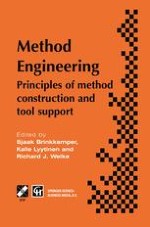1996 | Buch
Method Engineering
Principles of method construction and tool support
herausgegeben von: Sjaak Brinkkemper, Kalle Lyytinen, Richard J. Welke
Verlag: Springer US
Buchreihe : IFIP Advances in Information and Communication Technology
Enthalten in: Professional Book Archive
